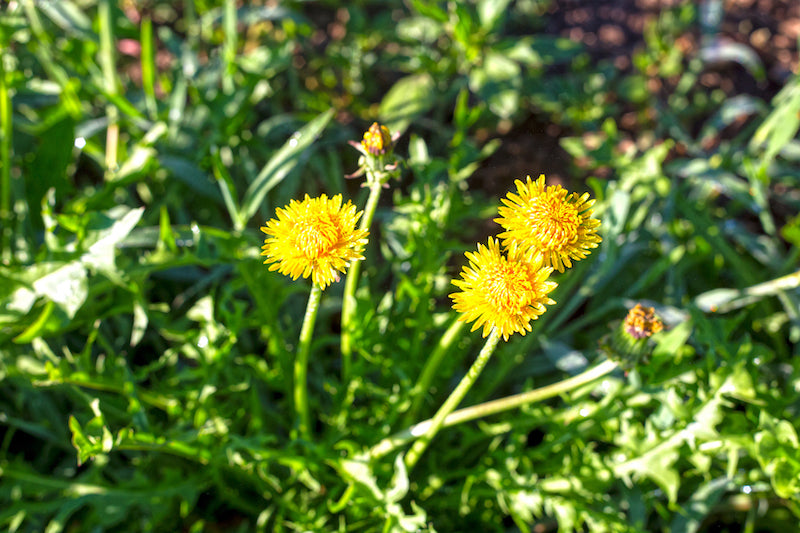Dandelion is indigenous to Greece and has been naturalized all over the Northern Hemisphere, including North America and Europe.2,6 The plant spontaneously grows in fields, along roadsides and in gardens.2,3,5 It is commonly considered a weed in grasslands and cultivated ground, and it is denoted as invasive in Kentucky, the Northeast, Nebraska, the Great Plains, the West and Canada.2,3,5 Since It belongs to the largest plant family of Asteraceae or the Daisy family, there are many Dandelion look-alikes.11 However, false Dandelions generally have hairy leaves, branched flower stems or a different root structure or shape.11
The plant’s first recorded use in herbalism was in the 900s and 1000s A.D. by Arabian physicians.11 Writings from 13th century Wales later alluded to Dandelion.11
The common name of Dandelion is said to be a derivative of the French “dent de lion” (tooth of a lion).8,10,11 The name originated from the peculiar indentations of the plant’s toothed leaves, which were said to resemble a lion’s jaw including the teeth.8,10,11 Others say the comparison might be of the yellow flowers to the golden teeth or the whiteness of the root to that of lion’s teeth.11 During the Middle Ages, another common name was Priest’s Crown.11 When the wind dispersed all the seeds, revealing the bare speckled receptacle, it was similar to a priest’s shaved head.11
Flowers appear on the plant generally from April to November.2 They are nyctinastic, meaning they open in the morning and close at night.11 Dandelion flowers also close when it rains on their petals, to protect their blooms.11 Among the plants that contribute to bees’ honeymaking process, Dandelion plays an important role due to the multitude of disc flowers.11 The characteristic Aster family flower head makes a bounty of nectar for thirsty pollinators, including bees and flies.11 Dandelion flowers generally begin blossoming in early spring just after the fruit tree blooms are finishing.11 They flower through late autumn, keeping beekeepers happy, as they do not have to then supplement the diet of their colonies.11
The plant is often harvested when flowering in both spring and fall.2 The tender, young leaves are often eaten in salads and blanched or boiled as greens.2,11 In late 1700s Germany, Coffee beans were imported and expensive, so many people substituted a tea made from the roasted, dried autumn-harvested roots of Dandelion.7 The flavor is bitter and similar to that of Coffee.7 In 1685, a swarm of locusts destroyed the entire food harvest in Minorca, off the coast of Spain.10 The population on the island reportedly survived on Dandelions.10
The dried leaves of the plant were also commonly used in herbal drinks and beers, while the flowers were used to make Dandelion wine.11 Dandelions are also used to feed animals such as pigs, goats, rabbits and small birds, who prefer the seeds.11
All parts of the plant are used as food, beverage, spice, folklore and in herbalism, by many Native American tribes from the Aleut to Tewa.4 The Hesquiat tribe makes toy whistles from the hollow stems.4
Children everywhere have played games with Dandelions by blowing their breath on the seed heads to scatter the seeds in the wind. A game in olden times was made of how many breaths it would take to disperse all the seeds, which would indicate the time of day.11
While Dandelion’s widespread use as a food goes far back in history, its cultivation is considered relatively modern.10 In the US in 1836, the plants were cultivated from wild plant seeds for a Boston farmers market.10 In England, the plant was noted in the Gardeners’ Chronicle, which dates back to 1841.10 The wild plant was written as a “spring potherb” in France in 1880.10 While it was cultivated there as early as 1868, the seeds were not available for sale until 1883.10
































